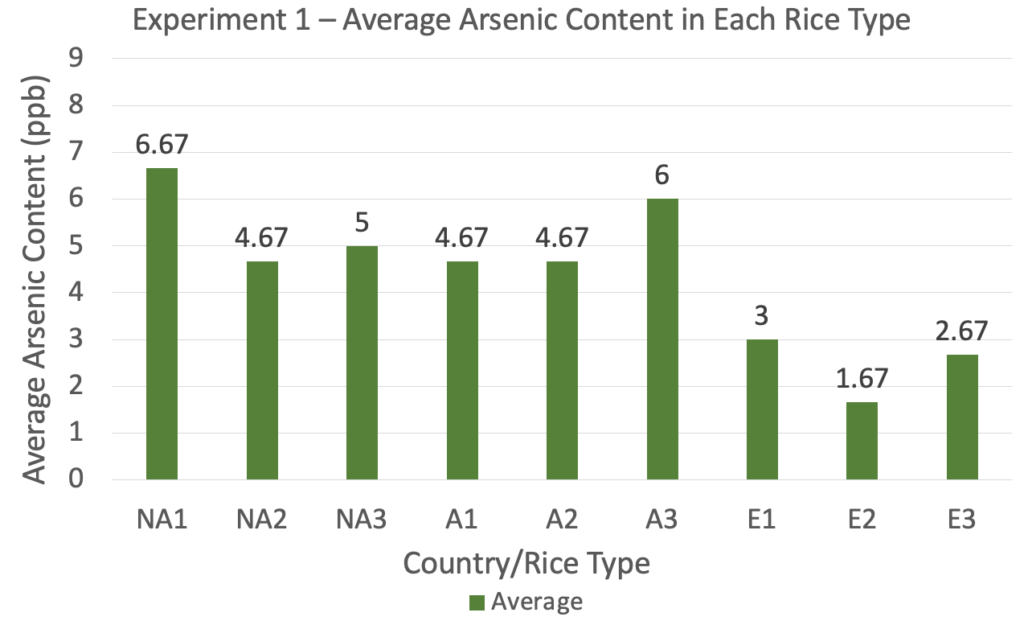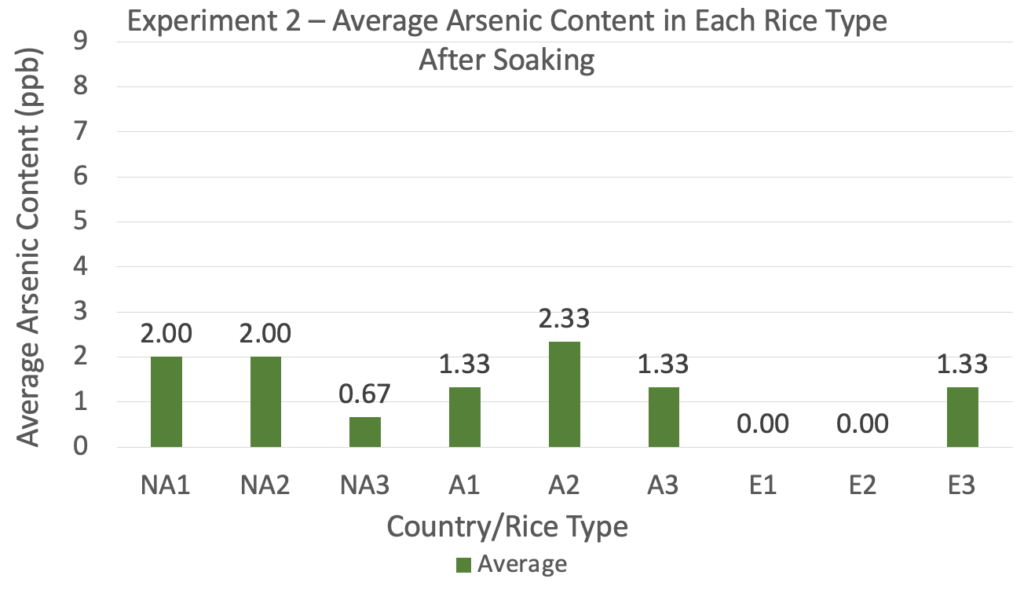An Exploration into a Novel Method of Arsenic Reduction in Rice
ABSTRACT
Rice, a food staple for over 3.5 billion people globally, is a rich source of carbohydrates and is affordable to grow and eat. However, the inorganic arsenic content in rice is not regulated by the World Health Organization in most countries. Exposure to inorganic arsenic can lead to numerous health effects, ranging from increased risk of diabetes to several types of cancer. This study aims to evaluate this carcinogenic agent in rice and create a method of reduction that can be used worldwide. To test this, two experiments were designed. First, the arsenic levels were determined in rice from various continents — Asia, Europe, and North America. It was hypothesized that Europe would have the least arsenic content due to the limits placed by the European Commission. Using an arsenic test kit, rice was boiled, and the residual water was tested for arsenic, and it was determined that Europe had the lowest average content of arsenic and North America had the highest. In the second experiment, soaking methods were tested to develop a home remedy. After soaking the rice in distilled water for six hours, arsenic amounts were reduced by an average of 73%. Through the soaking rice in water methodology, diet-based arsenic exposure can be reduced dramatically in households around the globe.
INTRODUCTION.
Rice is consumed in countries worldwide; however, only a limited number of countries have placed limits of inorganic levels of arsenic in rice [1]. Arsenic content varies based on the method of production of the rice and the type of rice produced as brown rice typically has more arsenic than white rice [2]. Rice is also consumed by a variety of ethnic and age groups, specifically infants and children. Arsenic exposure as a child has been linked to development of cancer and lung and heart diseases as a young adult [3].
Arsenic is a highly toxic element that is present in two forms — organic and inorganic. In inorganic arsenic, the arsenic atom is attached to another molecule, such as oxygen, chlorine, and sulfur, creating a complicated structure; however, organic arsenic is harmless and presented mainly in rocks. Organic arsenic compounds are not attached to other elements and do not contain carbon, so they have a simple structure; however, inorganic arsenic is highly toxic and frequently contaminates food and water [4]. Continuous exposure to inorganic arsenic can lead to many health effects on organ systems, such as the auditory, cardiovascular, developmental, hematologic, hepatic, nervous, renal and respiratory systems, and various types of cancer [5].
Arsenic has various sources of entry to rice grains. Arsenic is widely used in pesticides and fertilizers, and arsenic can remain in soil for over 45 years. Water used to grow the rice is also typically unfiltered water that contains large amounts of pollution and chemicals [2].
To cover a broad spectrum of rice types, rice samples from Europe, Asia, and North America were analyzed. It was hypothesized that European rice would have the least arsenic content. European farms are generally smaller and less commercialized and have decreased arsenic-containing pesticide usage on crops as compared to the other continents being tested. This can be attributed to the heavy use of pesticides in North America and Asia where rice is a cash crop. Furthermore, during crop rotation cycles, rice is grown in the same cotton and soy fields that contain large amounts of arsenic residue [6]. As a water-based crop, rice soaks this residual arsenic along with additional contaminants from water pollution. The secondary hypothesis predicts that soaking uncooked rice in clean water will remove some of the residual arsenic content of contaminated rice.
MATERIALS AND METHODS.
Experiment 1.
To create the rice water, 300 mL of distilled water was added to a beaker, which was then placed on a hot plate until the temperature reached 100°C (boiling point). 60 grams of rice was added, and was boiled for 7 minutes, then 100 mL of the liquid was poured into one of the reaction bottles provided with the test kit until it was cooled to about 22 to 28 °C. The bottle was cooled by placing it t in an ice-water bath to speed up the cooling process. After the liquid cooled, the Quick II Arsenic Test Kit was used to for arsenic evaluation. First, 3.75 cubic centimeter (cc) of the 1st reagent was added. Next, the bottle was capped (with a regular cap) and shaken for 15 seconds. Then, 0.45 cc of the 2nd reagent was added, the bottle was recapped and then shaken for 15 seconds. Next, the bottle was allowed to incubate for 2 minutes to minimize the sulfide interference. While the bottle was incubating, the turret cap was prepared. After the incubation period, the reaction bottle was uncapped and 0.45 cc of the 3rd reagent was added. The bottle was then capped, shaken for 5 seconds, and then the cap was replaced with the previously prepared turret cap. Immediately, the bottle was placed in an isolated area for 10 minutes. Finally, the turret cap and the test strip were removed, and the test strip results were recorded.
Experiment 2.
First, the rice was soaked by adding 60 grams of rice in water to 150 mL of distilled water for 6 hours. After soaking, the water was drained, and the rice was re-rinsed with 150 mL of water. Procedures from Experiment 1 were then repeated.
Data Analysis.
The Quick II Arsenic Test Kit uses colorimetric analysis to determine arsenic content in water. Using the provided color chart after completing the instruction to the rice water, the test strip was matched with the correct color. To match the color to the most accurate color natural sunlight was used, but not direct sunlight.
RESULTS.
In the Experiment 1, North America had the most average arsenic content at 5.4 ppb, and Europe had the least average content at 2.4 ppb (Figure 1). Asia contained more arsenic than Europe with an average of 5.1 ppb.

In the Experiment 2, the average reduction rate of arsenic was 73% across all continents (Figure 2). North American arsenic content in rice decreased from 5.4 to 1.33 ppb, Asian rice reduced from 5.1 to 1.67 ppb, and European rice reduced from 2.4 to 0.44 ppb.

A two-tailed t-test showed that comparing arsenic content in rice before and after soaking had a p-value less than 0.05 Results showed that all p-values were under 0.05, stating that the data is considered statistically significant. Therefore, it can be concluded that the method of soaking can be used to reduce arsenic contamination in rice.
DISCUSSION.
Both hypotheses were proven to be correct; arsenic amounts are the lowest in Europe as compared to other continents, and arsenic content can be reduced by about 73% by soaking the rice overnight. In the first experiment, North America had the most arsenic content, whereas Europe had the least content. Then, in the second experiment, the average reduction rate was 73% between all continents. North American rice’s arsenic content decreased the greatest amount from 5.4 to 1.33 ppb and European rice decreased as well from 2.4 to 0.44 ppb. Thus, proving that arsenic levels can be reduced by 73% by simply soaking uncooked rice in clean water overnight.
Over the course of the experiment multiple observations were made. When running the experiment, it was important to maintain precise measurements. Even minimal excess of reagents/rice water caused the hydrogen gas bubbles to rise and touch the test strips – disrupting test results before the 10-minute mark was even over. Additionally, due to the rice absorbing water at different rates, some of the rice had more water than others after boiling. Therefore, some rice brands had to be cooked multiple times to gather sufficient water for all three trials. Further, during the first few trials, test strips observed in direct sunlight were noticed to darken the strips. Disrupted trials were rerun in low light conditions. Finally, during the first trial, after the rice was boiled for seven minutes, the rice water was immediately poured into the reaction bottles – without cooling which resulted in the melting of the plastic reaction bottle. All future trials, therefore, included a cooling procedure.
This experiment could be taken a step further in multiple directions. A few include testing the arsenic content of different pesticides, comparing the arsenic content in organic and non-organic rice, and soaking the rice for 48 hours to determine if arsenic content is further removed.
The arsenic content in rice is evident in this study and emphasizes the need to develop methods and regulations on carcinogens in food. This method of soaking can easily be applied to families globally, and the water used to soak the rice can also be used for hair and skin benefits. Reducing exposure to carcinogens is vital in our world with constant pollution of our environment, and this study provides a simple and effect method to limit this evident contamination.
ACKNOWLEDGMENTS.
I would like to acknowledge Latha and Ramesh Nadella for assisting with this study.
REFERENCES
- Hojsak I, et al. ESPGHAN Committee on Nutrition. Arsenic in rice: a cause for concern. J Pediatr Gastroenterol Nutr. 60(1):142-5 (2015).
- Su, L. J., Chiang, T. C., & O’Connor, S. N. Arsenic in brown rice: do the benefits outweigh the risks? Frontiers in nutrition, 10, 1209574 (2023).
- Shohreh F. Farzan, Margaret R. Karagas, Yu Chen (2013). In utero and early life arsenic exposure in relation to long-term health and disease. Toxicology and Applied Pharmacology, 27(2): 384-390 (2013).
- Schwarcz, Joe. 2018. “What is the difference between organic and inorganic arsenic?”. [accessed 2023 Nov 15]. https://www.mcgill.ca/oss/article/health/what-difference-between-organic-and-inorganic-arsenic.
- Tchounwou, P.B.; Yedjou, C.G.; Udensi, U.K.; Pacurari, M.; Stevens, J.J.; Patlolla, A.K.; Noubissi, F.; Kumar, S. State of the science review of the health effects of inorganic arsenic: Perspectives for future research. Environ. Toxicol, 34, 188–202 (2019).
- Pittock, Jamie. 2019. “Cotton and rice have an important place in the Murray Darling Basin.” [accessed 2023 Nov 18]. https://theconversation.com/cotton-and-rice-have-an-important-place-in-the-murray-darling-basin-109953#:~:text=The%20trade%20in%20water%20allocations,droughts%20more%20frequent%20and%20intense.
Posted by buchanle on Tuesday, April 30, 2024 in May 2024.
Tags: arsenic, Carcinogens, Rice, Soaking

